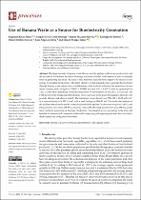| dc.contributor.author | Rojas-Flores, Segundo | |
| dc.contributor.author | De La Cruz-Noriega, Magaly | |
| dc.contributor.author | Nazario-Naveda, Renny | |
| dc.contributor.author | Benites, Santiago M. | |
| dc.contributor.author | Delfín-Narciso, Daniel | |
| dc.contributor.author | Angelats-Silva, Luis | |
| dc.contributor.author | Murga-Torres, Emzon | |
| dc.date.accessioned | 2022-07-18T16:58:35Z | |
| dc.date.available | 2022-07-18T16:58:35Z | |
| dc.date.issued | 2022-05-09 | |
| dc.identifier.uri | https://hdl.handle.net/20.500.13067/1966 | |
| dc.description.abstract | The large amounts of organic waste thrown into the garbage without any productivity, and the increase in the demand for electrical energy worldwide, has led to the search for new eco-friendly ways of generating electricity. Because of this, microbial fuel cells have begun to be used as a technology to generate bioelectricity. The main objective of this research was to generate bioelectricity through banana waste using a low-cost laboratory-scale method, achieving the generation of maximum currents and voltages of 3.71667 ± 0.05304 mA and 1.01 ± 0.017 V, with an optimal pH of 4.023 ± 0.064 and a maximum electrical conductivity of the substrate of 182.333 ± 3.51 µS/cm. The FTIR spectra of the initial and final substrate show a decrease in the peaks belonging to phenolic compounds, alkanes, and alkenes, mainly. The maximum power density was 5736.112 ± 12.62 mW/cm2 at a current density of 6.501 A/cm2 with a peak voltage of 1006.95 mV. The molecular analysis of the biofilm formed on the anode electrode identified the species Pseudomonas aeruginosa (100%), and Paenalcaligenes suwonensis (99.09%), Klebsiella oxytoca (99.39%) and Raoultella terrigena (99.8%), as the main electricity generators for this type of substrate. This research gives a second use to the fruit with benefits for farmers and companies dedicated to exporting and importing because they can reduce their expenses by using their own waste. | es_PE |
| dc.format | application/pdf | es_PE |
| dc.language.iso | eng | es_PE |
| dc.publisher | MDPI | es_PE |
| dc.rights | info:eu-repo/semantics/openAccess | es_PE |
| dc.rights.uri | https://creativecommons.org/licenses/by/4.0/ | es_PE |
| dc.subject | Banana waste | es_PE |
| dc.subject | Bioelectricity | es_PE |
| dc.subject | Microbial fuel cells | es_PE |
| dc.subject | Organic waste | es_PE |
| dc.title | Use of Banana Waste as a Source for Bioelectricity Generation | es_PE |
| dc.type | info:eu-repo/semantics/article | es_PE |
| dc.identifier.journal | Processes | es_PE |
| dc.identifier.doi | https://doi.org/10.3390/pr10050942 | |
| dc.subject.ocde | https://purl.org/pe-repo/ocde/ford#2.02.04 | es_PE |
| dc.publisher.country | PE | es_PE |
| dc.source.volume | 10 | es_PE |
| dc.source.issue | 5 | es_PE |
| dc.source.beginpage | 1 | es_PE |
| dc.source.endpage | 12 | es_PE |


